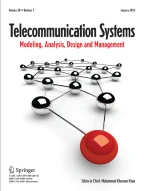Abstract
The B‐ISDN will carry a variety of traffic types: the Variable Bit Rate traffic (VBR), of which compressed video is an example, Continuous Bit Rate traffic (CBR), of which telemetry is an example, Data traffic, and Available Bit Rate traffic (ABR) that represents aggregate data traffic with very limited guarantees on quality. Of these, VBR and CBR have timing constraints and need synchronous bandwidth; data traffic is relatively delay insensitive. In this paper, we consider the VBR, Data and ABR traffic types and obtain the cumulative distribution function (cdf) of the queueing delay experienced by a burst of ABR traffic in the output buffer of an ATM switch. The cdf is used to trade off buffer loss probabilities against deadline violation probabilities through adjusting the buffer size and (delay) deadline values. Large buffers result in low losses but queueing delays can become excessive and cause a high level of deadline violations. Both losses and violations are detrimental and an operating point must be chosen to achieve a balance. In this paper we study the nature of the trade off. We develop a stochastic Petri net model assuming periodic burst arrivals for VBR and Poisson arrival processes for the Data and ABR traffic types at the burst level, and solve the model analytically (numerically) using a decomposition approach. This decomposition, along with the inherent decomposability of the tagged customer approach for obtaining the cdf opens up a possibility of carrying out fast computations using a parallel machine for selecting the operating point each time that a call is admitted.
Similar content being viewed by others
Explore related subjects
Discover the latest articles, news and stories from top researchers in related subjects.References
G. Ciardo, J. Muppala and K.S. Trivedi, SPNP: Stochastic Petri Net Package, in: Proc. Int. Conf. on Petri Nets and Performance Models, Kyoto, Japan (December 1989) pp. 142–150.
A. Demers, S. Keshav and S. Shenker, Analysis and simulation of a fair queueing algorithm, Internetworking: Research and Experience 1 (1990) 3–26.
W. Fischer and K. Meier-Hellstern, The Markov-modulated Poisson process (MMPP) cookbook, Performance Evaluation 18 (1992) 149–171.
S.J. Golestani, A stop and go queueing framework for congestion management, in: Proc. of the ACM Sigcomm, Philadelphia (September 1990) pp. 8–18.
L.W. Grovenstein, C. Pittman, J.H. Simpson and D.R. Spears, NCIH services, architecture and implementation, IEEE Network 8(6) (special issue: North Carolina information highway) (December 1994) 20–37.
R. Handel and M.N. Huber, Integrated Broadband Networks: An Introduction to ATM-based Networks (Addison-Wesley, 1991).
K.K. Leung and D.M. Lucantoni, Two vacation models for token ring networks where service is controlled by timers, Performance Evaluation 20 (1994) 165–184.
D.M. Lucantoni, G.L. Choudhury and W. Whitt, The transient BMAP/G/1 queue, Stochastic Models 10(1) (1994).
P.E. McKenney, Stochastic fairness queueing, Internetworking: Research and Experience 2 (1991) 113–131.
J.K. Muppala, K.S. Trivedi, V. Mainkar and V.G. Kulkarni, Numerical computation of response time distributions using stochastic reward nets, Ann. Oper. Res. 48 (1994) 267–318.
A.K. Parekh and R.G. Gallager, A generalized processor sharing approach to flow control in integrated services networks: The single-node case, IEEE Trans. Networking 1(3) (June 1993) 344–357.
H. Takagi, Queueing analysis of polling models: An update, in: Stochastic Analysis of Computer and Communication Systems, ed. H. Takagi (North-Holland, Amsterdam, 1990) pp. 267–318.
R.W. Wolff, Stochastic Modeling and the Theory of Queues (Prentice-Hall, Englewood Cliffs, NJ, 1989).
Z.-L. Zhang, D. Towsley and J. Kurose, Statistical analysis of generalized processor sharing scheduling discipline, in: Proceedings of the Third INFORMS Telecommunications Conference, Boca Raton, FL (1994) p. 143.
Author information
Authors and Affiliations
Rights and permissions
About this article
Cite this article
Balakrishnan, M., Puliafito, A., Trivedi, K. et al. Buffer losses vs. deadline violations for ABR traffic in an ATM switch: A computational approach. Telecommunication Systems 7, 105–123 (1997). https://doi.org/10.1023/A:1019164110511
Issue Date:
DOI: https://doi.org/10.1023/A:1019164110511
